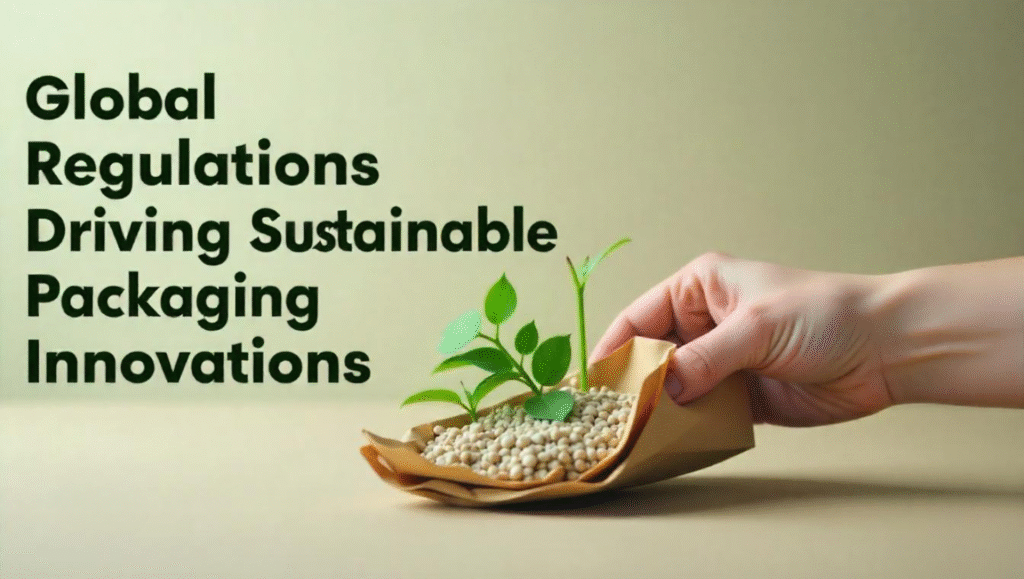
With the world’s plastic crisis now hitting India’s USD 204.81 billion packaging industry, which is expected to expand at a 26.7% CAGR until 2027, rigorous rules on single-use plastics are driving a tsunami of material change.
Bans and requirements, from India’s Plastic Waste Management Rules to the EU’s Single-Use Plastics Directive, are compelling businesses to look to biodegradable and recycled-content solutions.
These regulations dovetail with India’s Swachh Bharat Mission and international sustainability objectives but are hindered by high expenditure and infrastructure issues for widespread implementation, especially among smaller enterprises. International regulations are redefining packaging.
India’s 2016 Plastic Waste Management Rules, revised in 2021, prohibit single-use plastics such as straws, cutlery, and thin carry bags, requiring 25% recycled content in packaging by 2030 under Extended Producer Responsibility (EPR). The EU 2019 directive prohibits 10 single-use plastic products, mandating 50% recycled PET in bottles by 2030. Worldwide, 127 nations have applied plastic taxes or bans, according to a 2024 UNEP report, affecting India’s USD 2 billion packaging export business.
With 26 million tones of plastic waste produced in India each year—60% landfilled or burned, according to a 2024 report by the CPCB—these policies are creating a transition to sustainable materials in order to stem the 2.8 gigatons of CO2 emissions expected from plastics by 2050.
Biodegradable substitutes are on the rise. Polylactic acid (PLA) sourced from corn starch is utilized by firms such as UFlex for biodegradable food packaging, which breaks down within 180 days under industrial conditions, according to a 2023 study by IIT Bombay.
Polyhydroxyalkanoates (PHA) sourced through bacterial fermentation also provide marine biodegradability, which startups such as Boson White Water have taken up for flexible films. These substances cut dependence on 8% of the world’s oil utilised for plastics, according to a 2024 report by FICCI.
In e-commerce, expanding 20% each year, Amul’s PLA pouches have reduced carbon footprints by 30%, keeping pace with consumer needs, with 65% of urban Indians preferring green packaging, according to a 2024 Nielsen survey.
Recycled-content innovations are taking a leap forward as well. Chemically recycled PET (rPET), made possible by startups such as Banyan Nation, is of food-grade quality, recyclable to 90% compared to 9% in mechanical recycling, according to a 2024 CII report. Reliance Industries’ CircuLite rPET, found in drink bottles, satisfies EPR’s recycled-content requirements, cutting virgin plastic usage by 25%.
Enzymatic recycling, led worldwide by Samsara Eco and domestically researched by IIT Delhi, disassembles mixed plastics into monomers, allowing infinite reuse. These developments back India’s goal of recycling 70% of plastic waste by 2030, easing landfill pressure.
Innovations are filling performance gaps. Nanocellulose additives, created by IIT Madras, increase the tensile strength of bio-PLA by 20%, making it suitable for rigid packs.

Bio-based polyethylene (bio-PE), extracted from sugarcane, is equally durable as fossil-based PE, and Huhtamaki India has taken it up in flexible pouches. Hybrid packaging with 80% recyclable content and PHA coatings, displayed by Tetra Pak at a recent expo, reduces emissions by 35%. These products meet BIS’s low-VOC requirements and REACH, making exports to the EU, which is 15% of India’s packaging market, easier.
Government actions are driving adoption. The Production-Linked Incentive (PLI) scheme, which has Rs. 50,000 crore for the National Research Foundation (NRF), encourages R&D of green materials.
The Raising and Accelerating MSME Performance (RAMP) program helps smaller companies, which account for 40% of packaging, implement sustainable technology.
PM Gati Shakti enhances waste collection logistics vital for recycled-content supply chains. 2 million workers have been trained in advanced manufacturing under Skill India Digital Hub since 2023, with just 5% being skilled in bio-based materials, according to Nasscom.
There are still challenges. Biodegradable and recycled material are 20-30% more expensive than virgin plastics, constraining MSME adoption to 12%, according to a 2024 SIDBI report. Performance problems, such as PLA heat sensitivity, limit use in tropical environments. Infrastructure deficits, such as uneven power supply in Tier 2 cities, throw production off, costing SMEs Rs. 1-2 lakh every month, as observed in industry forums. Knowledge is limited among smaller suppliers, with cost being the priority over sustainability, and delays in regulation from patent approvals (4-6 years compared to China’s 2) hinder innovation.
ASEAN country competition from global markets, with reduced cost of production, is an added pressure.
Experts offer solutions. Subsidies under the Technology Upgradation Scheme can lower costs. Increasing Skill India’s training in bio-based materials can bridge skill gaps. Enhancing 5G connectivity and power dependability, as envisaged under PM Gati Shakti, will enable production.
IIT partnerships with public-private partnerships can speed up R&D. CII-initiated campaigns can promote awareness among MSMEs and consumers, boosting demand.
International norms are guiding India’s packaging sector towards eco-innovation, policy transformed into progress.
With a USD 3 billion market for materials by 2030, biodegradable and recyclable-content options are the drivers of a circular economy.
By overcoming cost, skill, and infrastructure challenges, Indian businesses can spearhead the war against plastic waste, creating a greener future for packaging.
